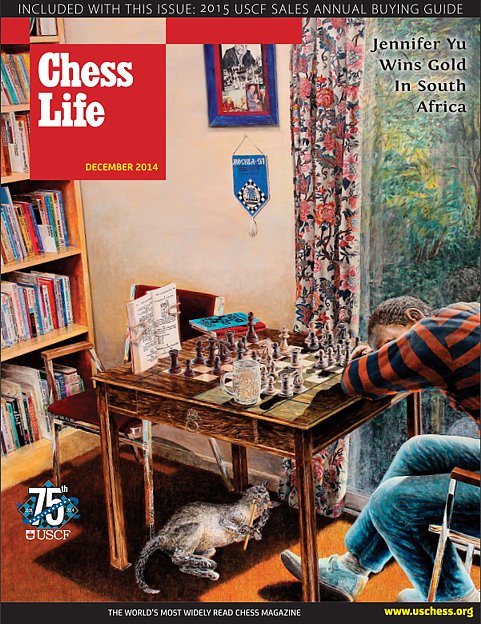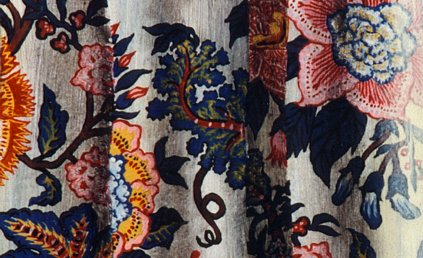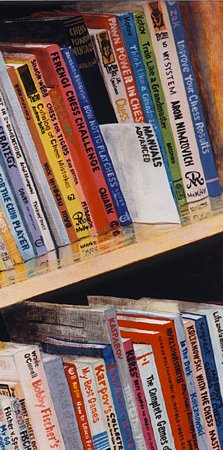|
|

|
|
SQUARE ONE
© 1996 Keith Halonen oil on panel 78×48 in / 198×122 cm $ 165,000 US THIS PAINTING IS A GOLDEN RECTANGLE |

|
« CLICK to contact the artist |





|
CLICK » to order this print |

|
|
YOU ARE IN THE CHESS PAINTINGS GALLERY
CLICK THE SHORTCUT ICONS ABOVE TO VIEW MORE PAINTINGS |
 |
|
The earliest mention of chess in literature occurs in the Sanskrit Vasavadatta, a prose romance composed by Subandhu in the earliest years of the 7th century. The title character is a the Princess of Ujjayini, who plays chess with her father, King Udayana of Vatsa, to while away time during the rainy season. It is safe to assume that if chess was at that time considered a game fit for royalty, it had most likely been already in popular vogue for over a hundred years. Chess seems to have been born in the Punjab, where some scholars estimate the date of its distinct evolution from earlier board games to be around 450 CE.
The first instructional chess manual was Repeticion de Amores e Arte de Axedres published by Lucena in 1497. The author devoted himself less to his analyses of chess openings than he did to a scathing attack on the rise of feminism. Damiano produced a chess manual in 1512. The Spanish priest Ruy Lopez de Segura deeply analyzed openings in his 1561 publication and participated in the first documented chess competition, Madrid, 1574. Today there are tens of thousands of chess titles, with three to four thousand volumes in print at any time. Since the advent of serious artificial intelligence experiments, chess has been the benchmark test for progress in the development of computing machines. At this point, sitting world champions have lost matches to powerful research laboratory computers, which have in turn been defeated by skillfully composed software programs currently retailing between $50 and $100. There are now several dozen popular chess playing software engines and over a hundred stand-alone chess computers ranging from full-size table models to hand-held portables. The weakest of these set at its lowest level is more than a match for the average casual player, and at their strongest levels they can consistently defeat all but the topmost tier of rated players, and they must struggle mightily just to maintain equality, never mind prevailing. I consider this oil painting to be a masterpiece. It is a golden rectangle, an ancient geometric construct which fascinates me. Within the rectangle the image area is divided into smaller golden rectangles which constitute the general design divisions of the image elements. This painting required about 1,250 hours of effort over a period of five years. Naturally, I couldn't devote myself to only one intense project for that duration. During the interim I worked on a companion piece and other paintings. Interior scenes can be very demanding and when the image concept calls for a bit of forced perspective, the difficulties multiply. The screen door imagery depended heavily on perspective and optical illusion. |
 
|

|
|
|
I felt a need to accurately depict my chess library. I did not want to merely suggest a large library. To convey the depth of chess acumen, it had to be a microcosmic version of a full library; not with the Dewey Decimal System, but the way a chess player might arrange it according to the divisions of the game and chess research categories. This may seem a bit much, but any player who has troubled to climb even a single plateau in the foothills of chess skill will soon be aware of the treacherous terrain which awaits high above. The Elo rating system is a 3,000 point bell curve. Every 200 points comprises a norm and when you consider that any player on the scale who is rated 200 points higher than his opponent enjoys a 76% win expectancy ratio over that opponent, you begin to realize how vertical the ascent must be. This is why the library is depicted in excruciating detail, right down to the titles and publishers' logos on the bindings. I admit that a few of the book titles are my own invention, an homage of sorts to Sir Richard Burton, the 19th century adventurer who found the source of the Nile. A linguist, explorer, and duellist, he was also a practical joker. He printed up dust jackets with mirthful book-titles, the idea being to trifle a bit with the very proper guests invited to his wife's tea soirées. Just before partygoers arrived, Burton would slip the dust jackets onto some of his books and leave them lying about on the end tables. The one title that sticks in my memory is, "The History of Farting in the Shetland Islands." It would be impractical, even impossible, to paint a screened view of an exterior scene. The screen and the exterior cannot share the same "depth of field," to borrow the photographic term. If a viewer's eyes are looking at the screen, the exterior view is completely out of focus. If the viewer is looking through the screen to the exterior view, then the screen is out of focus. Ideally, to create the appropriate illusion with art, some compromise between the extremes must be engineered. In any event, this scene's focus field would be even closer to the viewer than the screen, so both screen and exterior view are depicted nebulously rather than crisply. I first painted a very impressionistic exterior. Then I created a series of "horizontal" dull gold lines emanating from vanishing point left. Finally, I covered all with a grid of vertical but semi-transparent dark gray lines proceeding from the nadir vanishing point. The result is that the screen door area is "crosshatched" into tiny squares which collectively add up to 25% background exterior scene, 25% dull gold squares (representing sunlight reflected off the screen wire itself), 25% semi-transparent dark gray over dull gold, and 25% semi-transparent dark gray over background exterior scene. This is one of very few paintings for which I conducted an industrial time study, but at least now you know why it took some 1,250 hours! |
———————— GALLERIES ————————









|